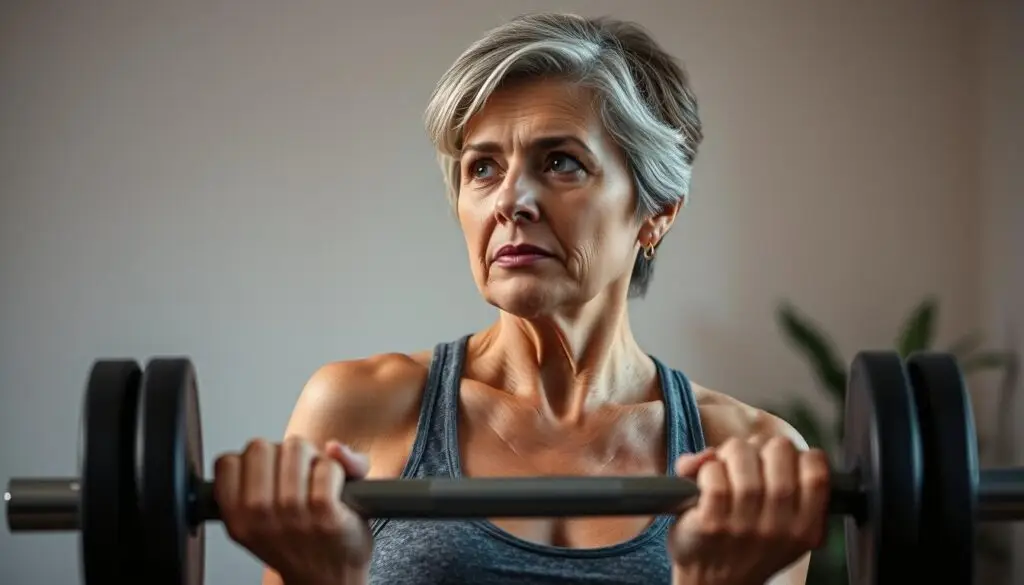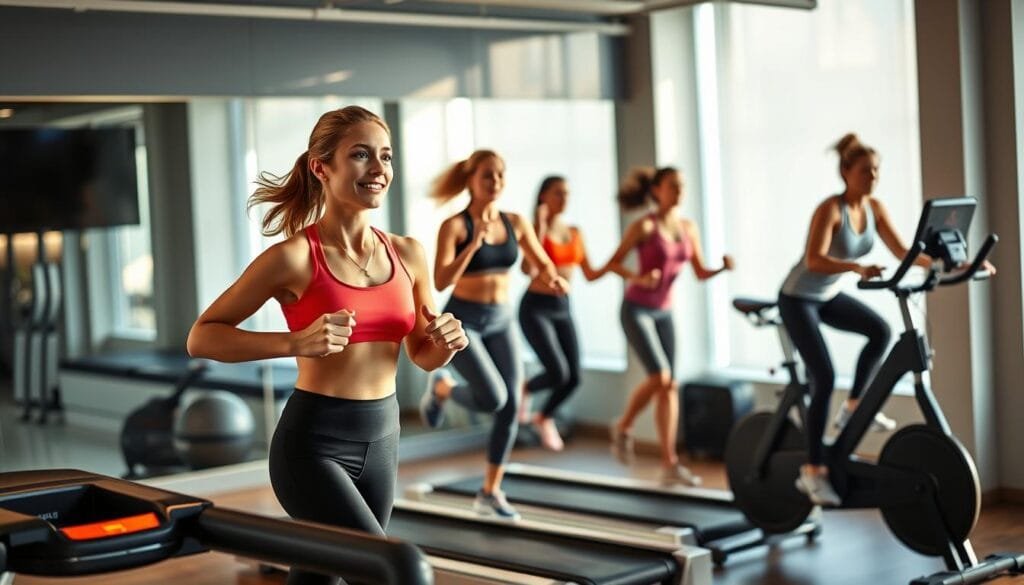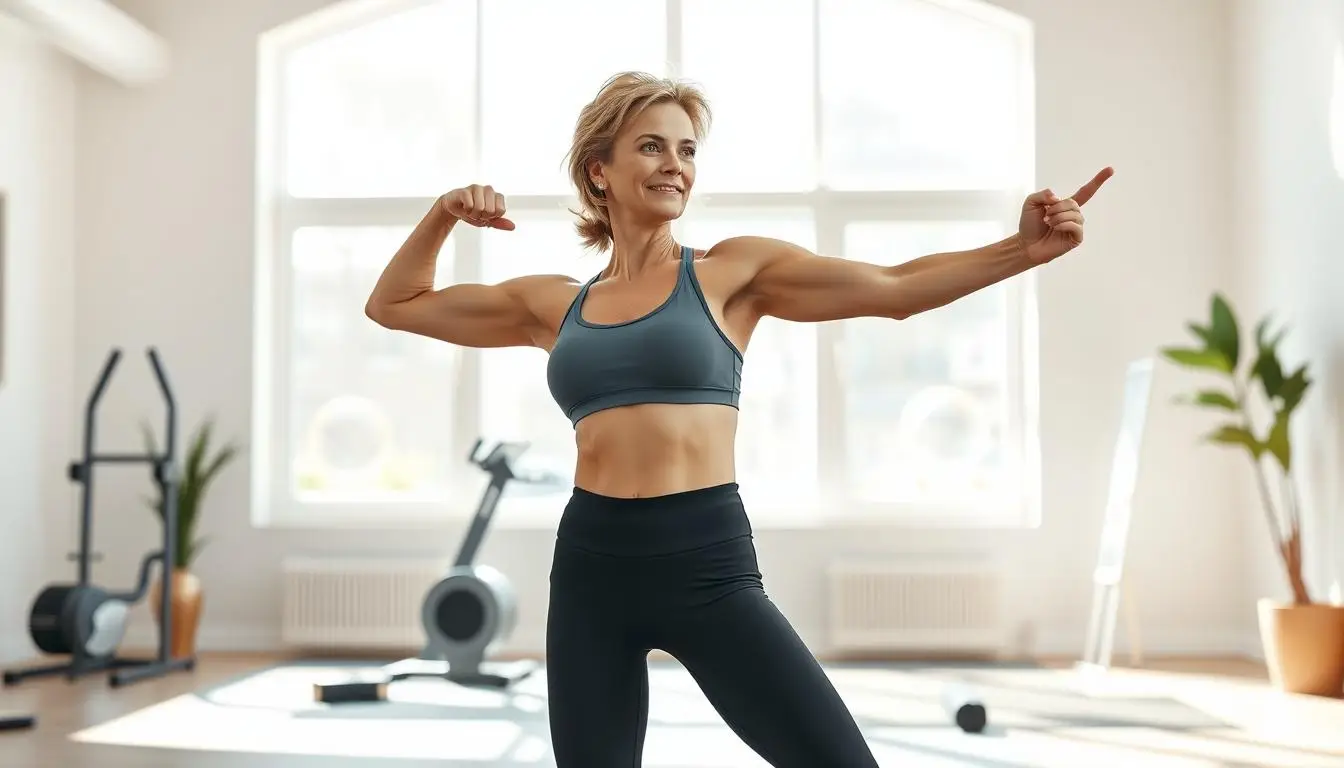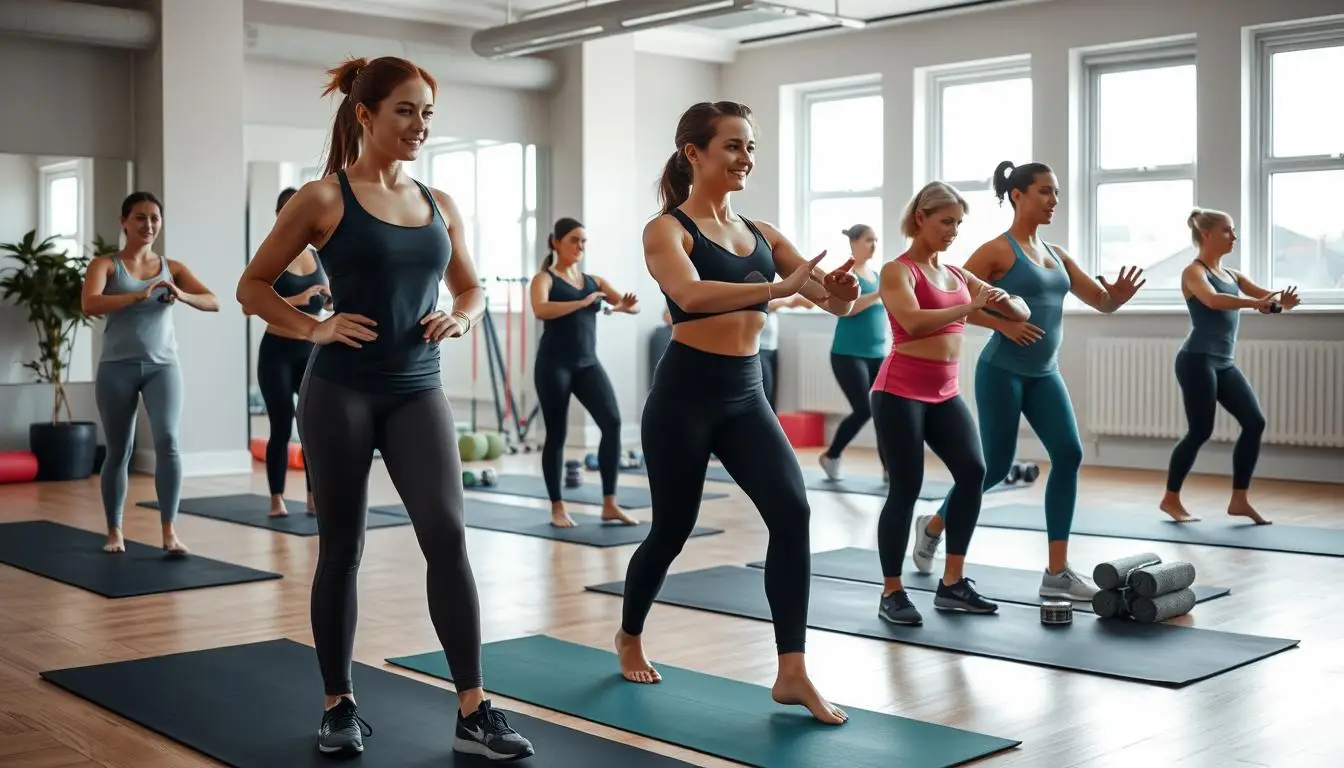Did you know that by 40, a woman’s estrogen levels can drop by up to 65%? This big change, called perimenopause, greatly affects fitness. This stage of life is when your hormonal changes drastically. It’s key to know how these changes impact your body and adjust your workout routine.
Hormonal shifts in perimenopause and menopause bring symptoms like hot flashes and mood swings. These can make it hard to stick to a workout plan. But, knowing how hormones affect fitness in midlife can help you stay active and healthy.
In this article, we’ll look at hormonal changes in women over 40 and how to improve your fitness. We’ll cover keeping muscle, managing weight, and boosting bone health. Get ready to tackle this new fitness chapter with confidence and strength.
Key Takeaways
- Understand the impact of estrogen decline on muscle mass and strength
- Learn strategies to navigate weight management challenges during perimenopause
- Discover exercises that promote bone health and prevent osteoporosis
- Explore ways to manage hot flashes and night sweats during exercise
- Gain insights on balancing hormones through nutrition and lifestyle changes
Recognizing the Role of Hormones in Midlife Fitness
When women hit their 40s, hormonal balance is key to staying fit. Female hormone changes, like a drop in estrogen, affect muscles, bones, and how well you move. Knowing these changes helps you adjust your workout and reach your midlife fitness goals.
Estrogen is important for keeping muscles strong. As estrogen drops during menopause, women lose muscle. This loss can make you weaker, slow down your metabolism, and increase injury risk. Adding strength training to your routine is a good way to fight this.
Hormonal shifts also affect bones. Lower estrogen means bones get weaker, raising the risk of osteoporosis. Doing exercises that make bones stronger and eating enough calcium and vitamin D can help keep bones healthy and prevent fractures.
Besides muscles and bones, female hormone changes can mess with energy, mood, and sleep. These issues might make it hard to stick to a workout plan. To help with your midlife fitness journey, try these tips:
- Focus on strength training to keep muscles and strength up
- Do exercises that make bones stronger
- Eat enough calcium and vitamin D, or take supplements
- Try stress-reducing activities like yoga or meditation for hormonal balance
- Stick to a regular sleep schedule to boost energy and recovery
By understanding how hormones affect midlife fitness and adjusting your workouts, you can stay healthy and full of energy during this important life stage.
How Estrogen Decline Affects Muscle Mass and Strength
Women in their 40s may notice changes in their body and strength. The main reason is the drop in estrogen levels during perimenopause and menopause. Knowing how estrogen impacts muscle and strength is key to staying fit and healthy in midlife.
Estrogen is important for keeping muscle mass and strength. When estrogen levels go down, women lose muscle, leading to weaker muscles and metabolism. This loss, called sarcopenia, makes it harder to keep a healthy weight and do daily tasks easily.
The Importance of Strength Training for Women Over 40
Women over 40 should focus on strength training to fight muscle loss from estrogen decline. Doing regular resistance exercises, like weightlifting or bodyweight exercises, helps keep or grow muscle. This improves strength, bone density, and overall function.
Strength training is great for women in midlife. It helps keep a healthy body shape, boosts metabolism, and aids in weight control. It also improves bone health, balance, and energy levels.
Adapting Workout Routines to Counteract Muscle Loss
When adding strength training to your routine, make sure it fits your needs and goals. Here are tips to adapt your workouts to fight muscle loss:
| Tip | Description |
|---|---|
| Focus on compound exercises | Do exercises that work many muscles at once, like squats, deadlifts, and push-ups. This makes your workouts more effective and efficient. |
| Gradually increase resistance | As you get stronger, add more weight or resistance. This keeps your muscles challenged and helps them grow. |
| Allow for adequate recovery | Rest days are important for muscle repair and growth. Make sure to have at least one to two rest days a week. |
| Maintain proper form | Focus on correct technique and form to get the best results and avoid injuries. Working with a certified fitness professional can help ensure you’re doing exercises right. |
By understanding how estrogen decline affects muscle and strength, and by adding strength training to your routine, you can keep a strong, healthy body in your 40s and beyond.
Navigating Weight Management Challenges in Perimenopause
Entering perimenopause can make it harder to keep a healthy weight. Hormonal changes affect your metabolism, making it easier to gain weight. But, you can manage your weight by understanding these changes and using effective strategies.
Weight gain in perimenopause often comes from lower estrogen levels. Estrogen helps control metabolism. As estrogen drops, your body burns calories less efficiently. Hormonal shifts also increase hunger and cravings, making it tough to eat well.
To fight these issues, focus on regular exercise and mindful eating. Cardio and strength training boost metabolism and keep muscle mass. Aim for 150 minutes of moderate exercise a week.
Choose whole, nutrient-rich foods to stay full and satisfied. Include fruits, veggies, lean proteins, and whole grains in your diet. These foods support health and weight management during perimenopause.
| Nutrient | Benefits for Weight Management | Food Sources |
|---|---|---|
| Protein | Helps maintain muscle mass and keeps you feeling full | Lean meats, fish, eggs, legumes, nuts |
| Fiber | Promotes satiety and aids in digestion | Fruits, vegetables, whole grains, legumes |
| Healthy Fats | Provide energy and support hormone production | Avocados, nuts, seeds, olive oil, fatty fish |
Watch your portion sizes and avoid processed foods, sugary snacks, and drinks. These can lead to weight gain and worsen hormonal imbalances. Instead, eat whole, minimally processed foods for sustained energy.

Stress management is also key in weight management during perimenopause. Chronic stress can raise cortisol levels, leading to weight gain. Try yoga, meditation, or deep breathing to reduce stress and support weight management.
Remember, everyone’s perimenopause journey is different. Be patient and focus on sustainable lifestyle changes for overall health. By prioritizing self-care, regular exercise, and a balanced diet, you can successfully navigate the weight management challenges that come with perimenopause.
Exercises to Promote Bone Health and Prevent Osteoporosis
As women hit their 40s, keeping bones strong is key. Hormonal shifts and bone density drops raise osteoporosis risk. But, certain exercises can boost bone strength and ward off osteoporosis.
Weight-Bearing Exercises for Optimal Bone Density
Weight-bearing exercises are vital for bone health. They make your body work against gravity, which helps bones grow stronger. Good examples include:
- Walking or jogging
- Dancing
- Stair climbing
- Tennis or pickleball
- Strength training with weights or resistance bands
Try to do at least 30 minutes of these exercises daily. As you get fitter, up the challenge by doing more and harder workouts.
The Role of Vitamin D and Calcium in Bone Health
Good nutrition is also essential for strong bones. Vitamin D and calcium are critical. Vitamin D helps your body use calcium, which is vital for bones. Make sure you get enough from:
- Eating foods high in calcium like dairy, leafy greens, and fortified items
- Spending time in the sun for vitamin D
- Talking to your doctor about supplements if needed
By exercising and eating right, you can help keep your bones healthy. This is important as you go through the changes of midlife.
Managing Hot Flashes and Night Sweats During Exercise
Women in perimenopause and menopause might feel hot flashes and night sweats. These can make working out tough. But, with a few easy tips, you can stay cool and keep exercising regularly.

Strategies for Staying Cool and Comfortable During Workouts
To manage hot flashes and night sweats, it’s key to keep your body cool while exercising. Here are some tips to help you stay cool:
- Work out in a cool place, like an air-conditioned gym or during the cooler hours of the day.
- Drink lots of water before, during, and after your workout.
- Take breaks as needed and listen to your body. If a hot flash hits, slow down or stop until it goes away.
- Use a portable fan or cold towel to cool down during your workout.
Choosing Breathable and Moisture-Wicking Workout Attire
The right workout clothes can really help with hot flashes and night sweats. Look for clothes that breathe and wick away moisture. This will keep you cool and dry. Some good features to look for include:
- Lightweight, loose-fitting fabrics like cotton or bamboo that let your skin breathe.
- Moisture-wicking materials, like polyester or nylon blends, that pull sweat away from your skin.
- Light colors that reflect heat, not dark colors that absorb it.
- Layering pieces, like a lightweight jacket or vest, that you can remove if you get too warm.
By using these strategies and picking the right workout clothes, you can reduce the effect of hot flashes and night sweats on your exercise routine. This way, you can stay comfortable and keep reaching your fitness goals during this life change.
Cardiovascular Exercise for Heart Health in Midlife
When you hit your 40s, taking care of your heart is more critical than ever. Regular cardio workouts are a top way to keep your heart healthy and lower heart disease risks. It’s vital to mix up your midlife fitness with different aerobic activities to strengthen your heart.

Cardio, or aerobic exercise, boosts your heart rate and blood flow. Examples include:
- Brisk walking
- Jogging or running
- Swimming
- Cycling
- Dancing
- Rowing
- Elliptical training
The American Heart Association suggests at least 150 minutes of moderate cardio or 75 minutes of vigorous cardio weekly. You can split this into 30-minute sessions, five days a week. Sticking to a routine is essential for heart health.
Regular cardio exercise does many good things for your heart:
- Strengthen your heart muscle
- Lower blood pressure
- Improve circulation
- Reduce heart disease, stroke, and type 2 diabetes risks
- Boost mood and reduce stress
- Maintain a healthy weight
Start your cardio routine slowly, at a pace you’re comfortable with. As you get fitter, increase the intensity and time of your workouts. Always drink water, wear good shoes, and talk to your doctor before starting any new exercise, even if you’re healthy.
By focusing on cardio in your midlife fitness, you’re taking big steps to protect your heart. This will help you stay healthy and feel great for many years.
Balancing Hormones Through Nutrition and Lifestyle Changes
As women hit their 40s, hormonal imbalances become more common. This can affect health and fitness. But, you can take steps to support hormonal balance through nutrition and lifestyle changes. Eating right and reducing stress can help you feel better during this time.

Foods That Support Hormonal Balance
Adding certain foods to your diet can help balance hormones. Key nutrients and foods include:
- Omega-3 fatty acids in fatty fish, chia seeds, and flaxseeds
- Leafy greens for calcium, magnesium, and vitamin K
- Whole grains and legumes for fiber and B vitamins
- Lean proteins like chicken, turkey, and tofu
- Healthy fats from avocados, nuts, and olive oil
Eating these foods can help balance hormones. As you make lifestyle changes, remember small steps lead to big improvements over time.
The Importance of Sleep and Stress Management
Good sleep and stress management are key for hormonal balance. Aim for 7-9 hours of sleep each night. Lack of sleep can upset hormone levels.
Manage stress well, as it can harm hormones. Try yoga, meditation, or deep breathing. Regular exercise, like walks, can also help.
By eating right and focusing on sleep and stress, you can face midlife challenges better. These changes are an investment in your long-term health.
Embracing Low-Impact Exercises for Joint Health
As women get into their 40s, taking care of their joints becomes more important. The aging process and hormonal changes can cause stiffness and discomfort. Luckily, low-impact exercises can help keep joints healthy and flexible, reducing injury risks.
Low-impact exercises are easy on the joints because they don’t put a lot of stress on them. They help strengthen the muscles around the joints, improve flexibility, and increase movement. Good options for women over 40 include:
- Swimming
- Cycling
- Elliptical training
- Yoga
- Pilates
Swimming, Cycling, and Elliptical Training Options
Swimming is a great low-impact exercise that works your whole body gently. The water supports your body, reducing joint stress and letting you move freely. Swimming also helps fight menopause belly by working many muscles and burning calories well.
Cycling, whether on a bike or outdoors, is good for your joints. It strengthens your leg muscles, which support your knees. Elliptical training is a low-impact way to get a cardio workout without the hard impact on your joints.

Incorporating Yoga and Pilates for Flexibility and Core Strength
Yoga and Pilates are great for improving flexibility, balance, and core strength. They help keep joints healthy by increasing movement and reducing stiffness. They also help with stress and relaxation, which is key for well-being.
Adding yoga and Pilates to your routine offers many benefits for your joints:
| Yoga Benefits | Pilates Benefits |
|---|---|
| Improves flexibility and range of motion | Strengthens core muscles |
| Reduces joint stiffness and discomfort | Enhances balance and stability |
| Promotes proper alignment and posture | Improves posture and alignment |
| Increases muscle strength and endurance | Increases flexibility and joint mobility |
“Yoga and Pilates are not just about physical fitness; they are about creating a balance between mind and body, which is essential for overall well-being.”
By mixing different low-impact exercises into your routine, you can keep your joints healthy, improve flexibility, and enhance your life as a woman over 40.
How to Understand How Hormonal Changes Will Impact Fitness Women Over 40s
Women in their 40s face important changes in their hormones. Knowing how these changes affect fitness is key. By spotting common symptoms and getting advice from doctors, you can stay healthy and active.
Identifying Common Hormonal Shifts and Their Symptoms
Perimenopause and menopause bring a drop in estrogen and progesterone. These changes cause symptoms that can mess with your workout plans. Symptoms include:
- Hot flashes and night sweats
- Mood swings and irritability
- Fatigue and sleep disturbances
- Weight gain and muscle loss
- Joint pain and stiffness
Knowing these symptoms helps you adjust your workouts. You might need to ease up, add stress-reducing activities, or focus more on rest.
Consulting with Healthcare Professionals for Personalized Guidance
It’s vital to talk to doctors about how hormones affect your fitness. See your primary care doctor often. Also, consider a certified fitness trainer who knows about women’s health.
Your healthcare team can tailor advice to fit your needs. They might suggest certain exercises, diet changes, or hormone therapy. This helps manage symptoms and improve your fitness plan.
“Seeking expert advice is key to understanding your body’s changing needs and creating a sustainable fitness plan that supports your overall health and well-being.”
Every woman’s hormonal journey is different. Listen to your body, watch for symptoms, and work with doctors. This way, you can craft a fitness plan that helps you shine in your 40s and beyond.
Staying Motivated and Consistent with Fitness Goals
Keeping up motivation and consistency is key to reaching your midlife fitness goals. Starting a new exercise routine is exciting, but staying committed long-term is tough. Here are some tips to help you stay on track:
Set goals that are realistic and achievable. Break them down into smaller steps so you can celebrate your progress. For example, aim to increase your strength training weights by 5% every month or to run a 5K race within 3 months.
Keep track of your workouts in a journal or with a fitness app. Seeing your consistency can motivate you to keep going. Also, note how you feel after each workout. The sense of accomplishment and energy boost can remind you of the benefits when motivation dips.
Find physical activities that you genuinely enjoy. If you dread your workouts, it’s harder to stick with them. Try different things like dance classes, hiking, swimming, or cycling until you find what resonates with you. Working out should feel rewarding, not like a chore.
“Success is the sum of small efforts, repeated day in and day out.” – Robert Collier
Surround yourself with support and accountability. Share your fitness goals with friends and family who will encourage you. Even better, find an exercise buddy or join a group class so you have companionship along the way. Having someone else counting on you to show up can prevent you from bailing on workouts.
Remember, consistency beats perfection. You don’t have to have the most optimized routine or hit PRs every session. What matters is regularly showing up and putting in the work. Some days will feel harder than others, but trust in the cumulative effect of your efforts.
| Strategy | Benefit |
|---|---|
| Set achievable goals | Builds momentum with quick wins |
| Track your workouts | Seeing progress is motivating |
| Find enjoyable activities | Makes fitness rewarding, not a chore |
| Get support and accountability | Others encourage you to stay committed |
With the right mindset, support system, and choice of activities, you can overcome the motivation challenges of midlife fitness. Stay focused on your goals, be consistent in your efforts, and celebrate the journey!
Building a Support Network of Like-Minded Women
Staying fit and healthy in your 40s and beyond can be tough. But, having a strong support network makes a big difference. Being around women who share your goals and experiences gives you the motivation and encouragement you need.
Joining local fitness groups or classes for women over 40 is a great way to build your network. These groups offer a friendly and understanding space. You can make friends and stay motivated in your fitness journey.
Online communities are also a great source of inspiration and accountability. There are many social media groups, forums, and websites for women over 40. These spaces let you connect with women worldwide, share your journey, and learn from others.
The Power of Accountability Partners
Finding an accountability partner is another way to strengthen your network. This could be a friend, family member, or someone who loves fitness as much as you do. Having someone to check in with and celebrate your wins can be very powerful.
Building a strong support network takes time and effort. But, the benefits are huge. Surrounding yourself with women who uplift and inspire you helps you overcome challenges and stay committed to your goals. It makes living a healthy, active life in your 40s and beyond more enjoyable.
FAQ
Q: What is menopause and how does it affect women’s bodies?
A: Menopause is that stage of life when a woman’s reproductive years come to an end, often marked by a decrease in estrogen. This can lead to a plethora of symptoms of menopause, including hot flashes, mood swings, and a delightful increase in body fat. It’s like your body decides it wants to throw a retirement party, but you didn’t even RSVP!
Q: How can resistance exercise help with menopausal symptoms?
A: Ah, resistance training! This form of exercise is a superhero in disguise when it comes to alleviating menopausal symptoms. It helps maintain lean muscle mass and can improve bone mineral density, which is crucial since postmenopausal women may experience a decrease in both. Think of it as giving your body a little pep talk: “Don’t worry, we got this!”
Q: Can women in perimenopause benefit from a regular exercise routine?
A: Absolutely! Women in perimenopause or menopause can significantly benefit from a regular exercise routine. Engaging in moderate to high-intensity exercise, including resistance training and aerobic fitness, can help mitigate those pesky symptoms of menopause and keep your physical and mental health in check. Plus, it’s a great excuse to wear cute workout gear!
Q: What type of exercise is best for managing menopausal symptoms?
A: While there’s no one-size-fits-all answer, a mix of resistance training, aerobic exercises, and even some high-intensity interval training (HIIT) can be your best bet. This variety not only keeps things interesting but also helps combat the risk of cardiovascular disease and manage body composition during this stage of life.
Q: Is it ever too late to start exercising during menopause?
A: It’s never too late to start! Whether you’re new to exercise or just getting back into the swing of things, incorporating physical activity can have profound benefits. Sedentary women often find that any form of exercise can help reduce the symptoms of menopause and improve overall well-being. So grab those sneakers—it’s time to move!
Q: How does resistance training affect body composition during menopause?
A: Resistance training plays a crucial role in maintaining lean muscle mass and combating the increase in body fat that often accompanies menopause. By incorporating this type of exercise into your routine, you can help counteract the decrease in lean muscle and manage body weight effectively. It’s like giving your metabolism a little wake-up call!
Q: Can exercise really help reduce the risk of cardiovascular disease in menopausal women?
A: Yes, indeed! Regular exercise can help lower the risk of cardiovascular disease, especially since menopausal women may experience an increase in visceral fat and insulin resistance. Engaging in physical activity not only strengthens your heart but also helps keep those pesky menopausal symptoms at bay. Talk about a win-win!
Q: What are the best tips for starting a new exercise routine during menopause?
A: Start slow and steady! If you’re new to exercise, consider beginning with moderate intensity workouts like walking or yoga, then gradually incorporate resistance training. Listen to your body, stay hydrated, and don’t forget to have fun! Remember, this journey is about enhancing your quality of life, not earning a gold medal.
Q: How often should I engage in resistance training during menopause?
A: Aim for at least two to three sessions of resistance training per week, focusing on all major muscle groups. This will help maintain your lean muscle mass and improve your overall physical fitness. Plus, you’ll be able to impress your friends with your newfound strength—who wouldn’t want to lift their own grocery bags?
Conclusion
As a woman over 40, it’s key to know how hormonal changes affect your fitness. This knowledge helps you keep your health and well-being in check. By understanding these changes, you can adjust your workouts and lifestyle to meet your body’s new needs.
Make sure to focus on strength training to prevent muscle loss. Also, do weight-bearing exercises to keep your bones strong. Choose low-impact activities to protect your joints. Eating right, getting enough sleep, and managing stress are also important for reaching your fitness goals.
Staying motivated and consistent can be tough. But, having a support network of women who share your goals and getting advice from health experts can help. Start this new fitness chapter with confidence, knowing you can keep your health and energy up for years.
By understanding hormonal changes and adjusting your fitness routine, you can keep living an active and meaningful life as a woman over 40. Celebrate your strength, resilience, and dedication to your health during this exciting time of growth and change.








